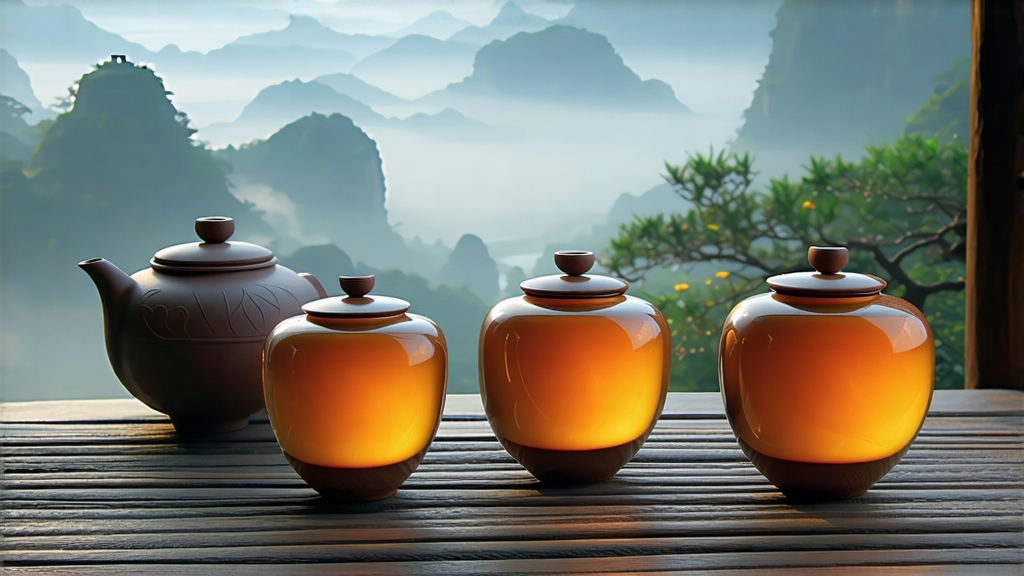
Tucked away in the humid, karst-pocked southwest of China, the small town of Liubao in Guangxi Zhuang Autonomous Region guards a tea secret that once steered the course of maritime trade. Liu Bao tea—pronounced “lyoh-bow”—is the oldest intentionally post-fermented black tea still produced today, yet it remains almost unknown outside specialist circles. While Pu-erh from Yunnan commands auction headlines, Liu Bao quietly slumbers in clay jars, growing mellower, sweeter, and more complex with every decade. To understand it is to glimpse the ancient arteries of the Tea Road that fed the docks of Guangzhou, Macau, and, ultimately, the teacups of nineteenth-century London dockworkers who drank it sweetened and braced with rum.
Historical Footprints
Liu Bao’s recorded history begins in the Ming dynasty (1368-1644), when local Tu and Yao minorities bartered compressed tea bricks for salt and iron along mountain trails. By the Qing Qianlong era (1736-1795), the tea had become a designated tribute, shipped down the Xun River to the Pearl River Delta and loaded onto “tea clippers” bound for Southeast Asia. In British ledgers it was catalogued as “black brick” or “basket tea,” valued for its stamina on long voyages; the humid ship holds accelerated its fermentation, deepening color and smoothing edges. When the Suez Canal opened in 1869 and steam replaced sail, Liu Bao lost its maritime edge, retreating into domestic obscurity until a 2006 resurgence driven by vintage collectors who discovered 1950s baskets selling for more than raw Pu-erh cakes twice their age.
Terroir and Leaf
The microclimate is decisive: subtropical monsoon rains, morning mountain mist, and iron-rich lateritic soils coax large-leaf Camellia sinensis var. sinensis to accumulate uncommon levels of polyphenols and amino acids. Gardens sit between 200–800 m on granite-derived slopes where temperature swings of 10 °C between day and night slow growth, thickening cell walls ideal for the strenuous post-fermentation ahead. Unlike Yunnan’s ancient arbors, Liu Bao bushes are mostly 40–80-year-old shrubs pruned into waist-high “tables” for convenient plucking. The standard harvest is one bud with three to four leaves, plucked after Qingming when spring rains have fattened the blades but before summer’s astringency sets in.
Craft: From Wok to Wet Pile
The processing choreography begins like green tea: a short wither, 260 °C wok kill-green for three minutes to arrest oxidation, then rolling for 40 minutes to rupture cells. The divergence appears in “duī wò” (wet-piling), a Guangxi invention that predates Pu-erh’s wò duī by at least a century. The rolled leaf is lightly sprayed, piled 70 cm high under jute tarpaulins, and left to ferment for 30–45 days. Internal temperatures climb to 55 °C; thermophilic microbes—Bacillus, Aspergillus, and rare Blastobotrys—convert catechins into theabrownins and gallic acid, yielding the tea’s signature earthy yet fruity bouquet. Every three days the pile is turned by barefoot workers who judge readiness by aroma: a shift from raw bean to betel-nut and dried longan signals completion. After piling, leaves are sun-dried, then steamed and pressed into 40 kg bamboo baskets lined with wild banana leaves. These baskets, called “lǒng,” allow micro-ventilation that continues aging for decades.
Styles and Vintages
Liu Bao is classified by both leaf grade and aging vessel. Top grades—Special (特级) and First (一级)—contain more tips, yielding a brighter, honeyed liquor. Storage vessels create further personalities: clay jars (tán chá) breathe, giving drier, mineral notes; basket tea (lǒng chá) retains a whisper of banana leaf sweetness; and the rare 1980s “brick” (zhuān chá) compressed under hydraulic presses offers a denser, camphor finish. Connoisseurs speak of “three stages”: young (1–5 years) shows plum-skin acidity; middle (6–15 years) develops woody depth; old (16+ years) reveals Chinese-medicine coolness, dark chocolate, and the elusive “betel-nut” (binglang) note prized in Chaozhou g